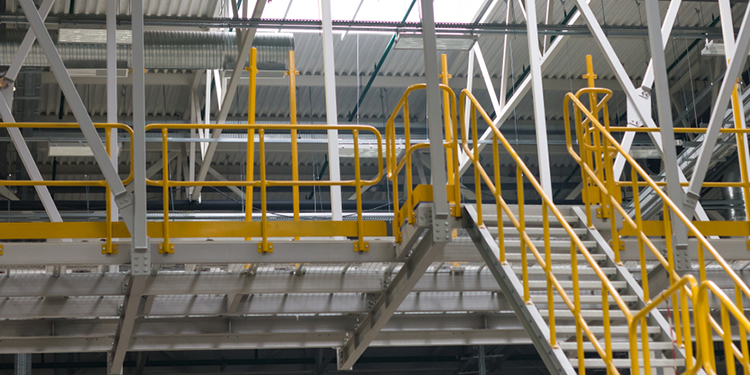How Elevated Work Platform Guardrails Enhance Worker Safety

With warehouse and distribution center storage at a premium, many operations are looking up and maximizing the overhead space in their facilities to expand their picking and fulfillment capacity. By utilizing elevated work platforms, pick modules, or rack supported platforms, a facility can expand its available square footage without a building expansion. Associates can work on these overhead areas to access stored items. For their safety—because they’re working above ground level—it is important to integrate permanent guardrails around the perimeter of these platforms or walkways to prevent associates from falling over the edge.
Two separate ANSI publications provide guidelines for the safe design of guardrails: RMI’s ANSI MH16.1: Specification for the Design, Testing and Utilization of Industrial Steel Storage Racks and ANSI MH32.1: Stairs, Ladders, and Open-Edge Guards for Use with Material Handling Structures, which was developed by RMI in partnership with the Storage Manufacturers Association (SMA).
Guardrails are defined as “members installed on an elevated rack-supported platform or pick module walkway whose purpose is to provide fall protection for the occupants of the structure. Guardrails consist of a top rail, an intermediate rail(s) and posts.” The horizontal top rail must be at a minimum height of 42 inches above the floor surface. Further, intermediate rails must be designed to prevent a 21-inch-diameter sphere from passing through any opening. For additional safety, the entire guardrail assembly must be designed to separately resist the force of a concentrated live load of 200 pounds, or a distributed live load of 20 pounds-per-foot.
Guardrails are not required in locations where other structural members provide fall protection. They are also not required in areas where they would interfere with a product being loaded into or removed from the structure. Where they are not present (typically in pallet drop areas or where safety gates are integrated), removable guardrail sections or removable chains must be used instead. To ensure worker safety, these removable devices must meet the same strength and configuration requirements of permanent guardrail.
The term “guardrail” is often confused with the term “handrail.” The two, however, refer to different things. Guardrails provide fall protection, while handrails are required on stairways to provide additional stability to persons ascending or descending from one level to another. Handrails can also serve as the top of guarding, as long as their position is between 34 inches and 38 inches from the tread surface and that they are built to prevent a 21-inch-diameter sphere from passing through any opening.
Want to learn more about the design requirements that ensure worker safety on elevated work platforms? Download the RMI/SMA ANSI MH32.1: Stairs, Ladders, and Open-Edge Guards for Use with Material Handling Structures specification.


